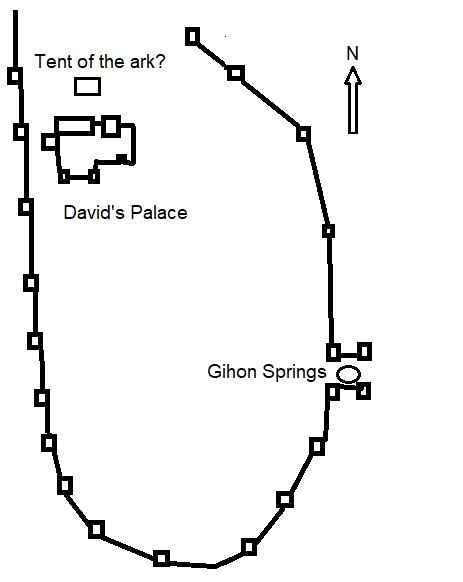God’s Word for You
1 Chronicles 15:1-10 The men to carry the ark
by Pastor Timothy Smith on Thursday, January 4, 2024

15:1 David constructed buildings for himself in the City of David, and he also prepared a place for the ark of God and pitched a tent for it.
One of the buildings David constructed was a palace for himself. He may have built fine houses for various wives and their children as well. The palace of David is usually thought to have been on the top of old Jerusalem’s northern slope. Five hundred years later, when Nehemiah was repairing the city after the exile, a group of worshipers at the dedication are described as taking a route “directly up the steps of the City of David on the ascent to the wall and passed above the house of David to the Water Gate on the east” (Nehemiah 12:37). Remains of a large, well-built, stone structure have been uncovered on the northwest slope of the old city. Adjacent to the northwestern part of the City of David, the palace’s location was “a logical step for someone who was already planning a northern expansion of the city—an expansion for the Temple…” (Eilat Mazar, archaeologist).
The tent David pitched for the ark was not the tabernacle of Moses. That tent was still at Gibeon (1 Chronicles 16:39; 2 Chronicles 1:3). We might wonder whether this tent was made to look like a duplicate of the combined holy place / most holy place, with inner and outer shrines, but there are no details in the Scriptures about this ohel la’aron “tent for the ark.” It was not commanded by the Lord, but it was not frowned upon: “His tent is in Salem,” Asaph sang, “his dwelling place in Zion” (Psalm 76:2).
2 Then David said, “No one but the Levites may carry the ark of God, because the LORD chose them to carry the ark of the LORD and to minister before him forever.”
This verse tells us that David had learned the truth about his error, that using a cart to transport the ark was dangerous and forbidden by God, and that the method of transport was that the ark should be carried by men, specifically Levites, on poles. The ark was built with rings for these poles: “Make poles of acacia wood and overlay them with gold. Insert the poles into the rings on the sides of the ark to carry it. The poles are to remain in the rings of this ark; they are not to be removed” (Exodus 25:12-15). The original poles, or their replacements (the ark and its poles were more than four hundred years old) were surely destroyed or stolen by the Philistines when they captured the ark in the days of Eli the priest. The ark had been returned to Israel on a cart, surely without any poles, and that appears to be where the trouble about the ark’s transport began.
3 Then David assembled all Israel at Jerusalem to bring up the ark of the LORD to the place he had prepared for it. 4 He gathered together the descendants of Aaron and the Levites: 5 From the sons of Kohath, Uriel the chief and 120 of his brothers; 6 from the sons of Merari, Asaiah the chief and 220 of his brothers; 7 from the sons of Gershon, Joel the chief and 130 of his brothers; 8 from the sons of Elizaphan, Shemaiah the chief and 200 of his brothers; 9 from the sons of Hebron, Eliel the chief and 80 of his brothers; 10 from the sons of Uzziel, Amminadab the chief and 112 of his brothers.
The “all” of “all Israel” here probably means all of the leaders of the people, the princes of the families, the military leaders, the priests, and anyone else who wanted to come. Here David includes specific names of the chiefs of the priestly and Levite families, along with the number of representatives who also attended from each branch. The original three families were represented: Kohath, Merari, and Gershon. The other three groups must have grown to such numbers that they felt a special distinction should be made. Both Hebron and Uzziel were sons of Kohath (Exodus 6:18). One of Uzziel’s sons was Elzaphan or Elizaphan (Exodus 6:22).
The poles of the ark were very long, more than 30 feet (2 Chronicles 3:8, 5:9). That would mean ten or twelve feet to a side (front right and left, back right and left), with room for about three or four men front and three or four in back (sixteen in all) or maybe five each (twenty in all). It is natural to consider that carrying the ark would have been considered the highest honor, and so the bearers were probably the six chiefs mentioned in the text, along with the two chief priests, Zadok and Abiathar (1 Chronicles 15:11), to have done this work. Perhaps the line in the Shepherd of Hermas reflects this, however distantly, about the twelve who were dressed in linen, each “with a shoulder bare, as if they were going to carry some load. They were ready and they were also very cheerful and eager” (Hermas, Hs 9,2,4).
It’s also possible and in keeping with certain outside traditions that, since the ark was not likely to be moved very much in the future after this, at least two very young men, newly ordained priests perhaps, might also have been included in the group, so that the memory of what was done and how it was done could be preserved for as long as possible. “Remember what you have received and heard” (Revelation 3:3; Psalm 143:5).
One of the additional lessons we learn as this account continues is this: “Whatever you do, work at it with all your heart, working as you work for the Lord, and not for men” (Colossians 3:23). “Let your work be complete on earth and in heaven and to honor God.”
In Christ,
Pastor Timothy Smith





